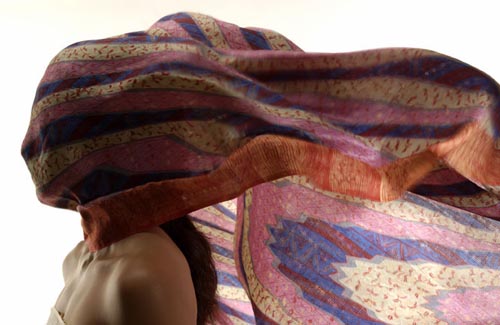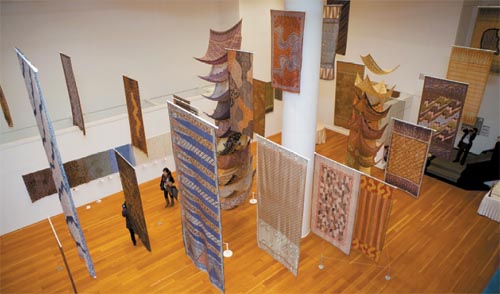Artisans weave history into fanciful fabrics

The exhibition “Wearable Art: Indonesian Batik Cloth,” which is currently on display at the Korea Foundation Cultural Center, explores the art of Indonesian batik through displays that are at once visually inspiring and viscerally engaging.
Batik is the centuries-old traditional textile art of Indonesia, which involves a repetitive process of resist printing and dyeing. Artisans draw motifs onto the cloth using a traditional canting pen to hold the molten wax. The cloth is then dyed and heated to burn off the wax and reveal the patterns. This process is repeated several times before a final work is produced, which generally takes about several months.
Last year, Indonesian batik gained worldwide recognition when it was designated a piece of Intangible Cultural Heritage by the United Nations Educational, Scientific and Cultural Organization.
“Batik is a form of traditional art in Indonesia and also represents our national identity,” said Kestity Pringgoharjono, the director of Preserve Indonesia, a private Indonesian organization that organized the exhibition in tandem with the KFCC.

Batik fabrics float high above the main gallery at the Korea Foundation Cultural Center in Seoul. Provided by the KFCC
“Indonesia is a beautiful and diverse country. There are people coming from many different regions in Indonesia, which is an archipelago of about 17,000 islands,” Obin said at a press conference last week. “It begets dynamic cultures, which are well reflected in the diversity of cloth it produces.”
In Indonesia, batik fabrics are an integral part of daily life and culture, the artist said. The fabrics are versatile and can be used to make sarongs (a long piece of batik cloth wrapped around the waist that is worn by both men and women in Indonesia) or wall hangings to decorate the home, while special batik fabrics are worn for sacred ceremonies.
“Cloth is something inseparable from our lives and it shows our way of living,” Obin said. “And the collection of pieces of cloth featured in this exhibition is my life’s work.”
Obin has been making textiles since 1977 and in 1986 founded BIN House, where about 2,000 artisans work and train in the art of batik, still using the traditional method of wax-resistant color and motif application.
“All of the batik pieces at BIN House are handmade and each one of them is a ‘unique’ piece of art in that it is the only one of its kind in the world,” she said.
“In my travels throughout Indonesia, I have met many local people and witnessed firsthand the beauty of Indonesian textiles made in different regions,” she continued. “During this time, I have found the common thread that connects the people of Indonesia - the use of cloth and textiles as wearable art.”
The artist said that she is happy to know that by making batik fabrics, she can contribute to the preservation of the traditions and cultures of about 300 Indonesian tribes, which are rapidly decreasing in number. She also hopes to touch people’s hearts and open their minds through her pieces of art.
“The exhibition offers those of us who are living in a world where almost everything is automated, to reflect on the significance of traditional handicrafts,” said Yoon Keum-jin, the director of the Korea Foundation Cultural Center.
*Wearable Art: Indonesian Batik Cloth runs until April 21 at the Korea Foundation Cultural Center in Sunhwa-dong, Jung District, central Seoul. Go to City Hall Station, line No. 2, exit 9. Admission is free and guided tours are offered at 2 p.m. on Wednesdays and Saturdays.
Accompanying the exhibition is a screening of Indonesian films. The films will be shown at 7 p.m. on Wednesdays and at 3 p.m. on Saturdays through April 28 at the center. The series features four Indonesian movies: “Three Wishes, Three Loves,” “The Rainbow Squad,” “Fiction” and “Forbidden Door.” Admission is free, but reservations are necessary for groups of 5 or more. For a detailed screening schedule and more information, call (02) 2151-6520 or visit www.kfcenter.or.kr.
By Park Sun-young [spark0320@joongang.co.kr]










with the Korea JoongAng Daily
To write comments, please log in to one of the accounts.
Standards Board Policy (0/250자)